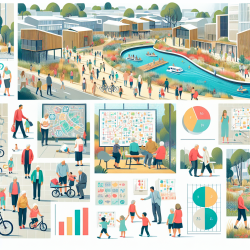Introduction
As practitioners dedicated to fostering the best outcomes for children, understanding the impact of our environment on health and wellbeing is crucial. The RESIDE study, a longitudinal natural experiment, provides valuable insights into how urban planning policies, specifically the "Liveable Neighborhoods" initiative in Perth, Western Australia, influence health-supportive behaviors and wellbeing outcomes. This blog delves into the findings of this study and how they can guide practitioners in enhancing their skills and encouraging further research.
The RESIDE Study: A Brief Overview
The RESIDE project evaluated the "Liveable Neighborhoods" planning policy, aiming to create more walkable and community-focused suburbs. The study tracked 1,803 participants who moved into new housing developments, assessing the impact of urban design features on behaviors such as walking, cycling, and sense of community.
Key Findings and Implications for Practitioners
The RESIDE study identified several urban design features that significantly impact health-supportive behaviors and wellbeing outcomes:
- Walking and Cycling: The study found that neighborhoods with well-connected streets, access to public transport, and proximity to parks and mixed-use centers significantly increased walking and cycling activities. Practitioners can advocate for these features in community planning to promote physical activity among children.
- Sense of Community: Access to local destinations and main-street configured centers enhanced the sense of community. Encouraging community engagement and social interactions can be beneficial for children's social development.
- Safety and Wellbeing: Features like street trees and public open spaces were associated with increased perceptions of safety and reduced fear of crime. Creating safe and inviting environments is essential for children's mental and emotional wellbeing.
Encouraging Further Research
While the RESIDE study provides a robust foundation, there is a need for further research to explore the long-term impacts of urban design on health and wellbeing. Practitioners are encouraged to collaborate with urban planners and policymakers to advocate for evidence-based design principles that support children's development.
Conclusion
The "Liveable Neighborhoods" policy in Perth offers valuable lessons for creating environments that support health and wellbeing. By integrating these findings into practice, practitioners can contribute to building communities where children thrive. For those interested in exploring the original research, please follow this link: Living liveable? RESIDE's evaluation of the “Liveable Neighborhoods” planning policy on the health supportive behaviors and wellbeing of residents in Perth, Western Australia.










